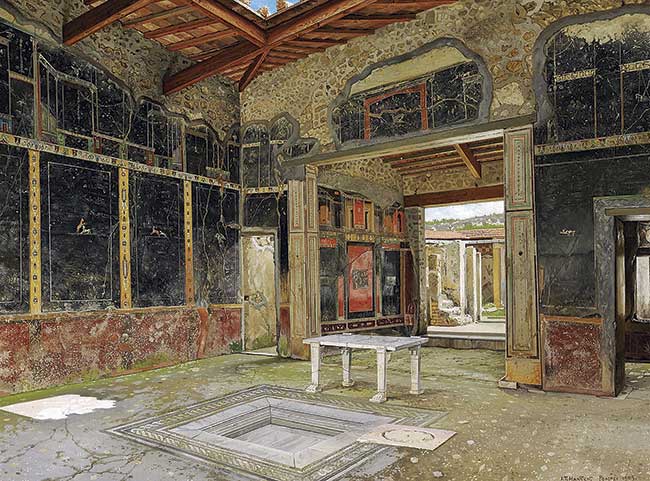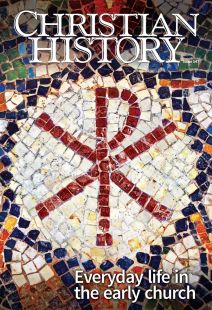Did you know? Everyday life in the early church
[above: Josef Theodor Hansen, Interior from Pompeii, 1905. Oil on Canvas—Public domain, Wikimedia]
Life among the pagans
The basic unit of Roman society was the family, and the father, called the paterfamilias, was its absolute head. He could even reject his own children from the family or sell them as slaves. Women could not vote, stand for office, or speak in public. As time went on, wealthier women, especially widows, gained the right to own property and manage their own affairs; we catch glimpses in the New Testament of wealthy women supporting Jesus’s ministry and the growth of the early church. Roman society considered the interior of the home as the women’s domain, and men generally did not interfere with household management.
House church
In the first century, what passed for a formal church service was a home-based affair, centered on a communal meal offered in the main room or courtyard of a family dwelling. The elders of the community would say prayers before the meal, and sometimes one of the elders would tell stories of the early days. Each community maintained its own isolated island of fellowship and prayer, and occasionally a traveling teacher would visit, telling stories and saying prayers that linked the little island to a wider fellowship.
A-B-C, 1-2-3
The commonly accepted statistic for the number of fully literate people in the Roman Empire is 5 to 10 percent, although some scholars think there were more. While the New Testament does show people reading and writing, we mostly need to think of the early church as a highly oral culture. In worship we know that Paul’s letters (and later the other New Testament books) as well as the Hebrew Scriptures were read aloud to the community; among other motivations, this benefited illiterate believers. Even the literate often used scribes. (Paul commonly did this and remarks about it when he deviates from the practice, such as in Galatians 6:11.)
Against the gods
Atheism, one of the leading charges against Christians, means “against gods.” Romans recognized it as a refusal to participate in social and civic activities honoring pagan deities. Pagan worship was intimately interwoven with the Roman state. Many different kinds of priests and priestesses populated the empire: augures, who studied omens to decide if the gods were pleased; pontifices, who helped the emperor in his religious duties; flamines, who served individual gods; the rex sacrorum and his wife, and the regina sacrorum, who spent their lives performing sacrifices for the state. In addition to all these religious classes were vestal virgins, who oversaw the Temple of Vesta in Rome. A proper Roman home, called a domus, had busts and wax images of ancestors, as well as a family altar for sacrifices to domestic gods and spirits called the lares and pentates.
Worship wars
Pagan spectacles such as athletic events and theater, which featured lavish choral singing, instrumental music, and dancing, surrounded early Christians. This created controversy over worship music: large choruses, instruments, and elaborate musical settings seemed too much like the old “shows” of the theaters from before their conversions. Instead early Christians either sang in unison or offered extemporaneous solos as their musical forms of worship. They chanted the Psalms as well as singing newly composed hymns and antiphons (refrains). Some of these hymns seem to be quoted in the New Testament (see Philippians 2:5–11).
Why did Christianity grow?
Between Jesus’s Resurrection and the legalization of Christianity in 313, the church grew from a small group of faithful disciples—fewer than 100—to almost 60 percent of the population of the Roman Empire. Why? A number of factors influenced church growth.
One was the relatively prominent role and voice the new faith gave to slaves and women compared to traditional Roman society. To take one prominent example, the Onesimus who was bishop of Ephesus in the late first century is traditionally thought to be the same slave Onesimus mentioned in the Epistle to Philemon. Another factor was the way Christians cared for the sick and the poor—not only their own, but pagans as well—during times of plague and famine. Paul and other missionaries spreading the faith through cosmopolitan urban centers helped as well. People saw in the Way (its earliest name) a dignity and compassion that countered the decadence and callousness of the pagan world. CH
By the editors and Kate Cooper
[Christian History originally published this article in Christian History Issue #147 in 2023]
“Life among the pagans” and “Against the gods” are adapted from our issue #124 on faith in the city, and “Worship wars” from our guide to the history of worship from Constantine to the Reformation. “House church” is taken from Band of Angels by Kate Cooper (for more, see pp. 34–37).Next articles
Letters to the editor. Everyday life in the early church
Readers respond to Christian History
readers and editorsEditors note: Everyday life in the early church
The Christian faith denied a central organizing principle of the Roman state.
Jennifer Woodruff TaitA day in the life
What did it feel like to be a follower of the Way at the very beginning?
James L. PapandreaSupport us
Christian History Institute (CHI) is a non-profit Pennsylvania corporation founded in 1982. Your donations support the continuation of this ministry
Donate








